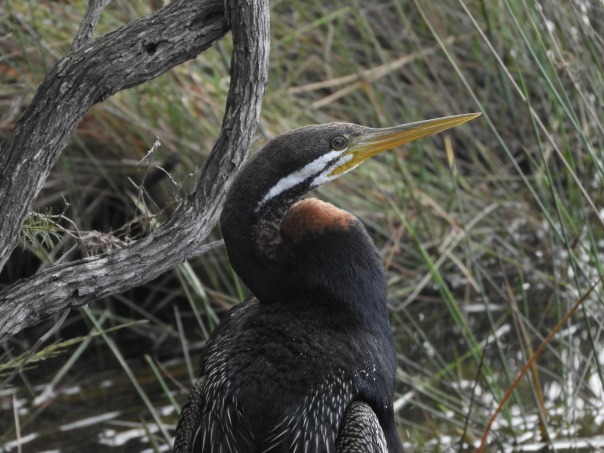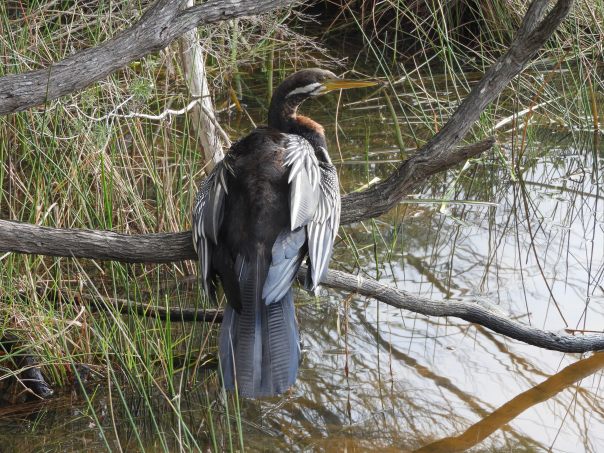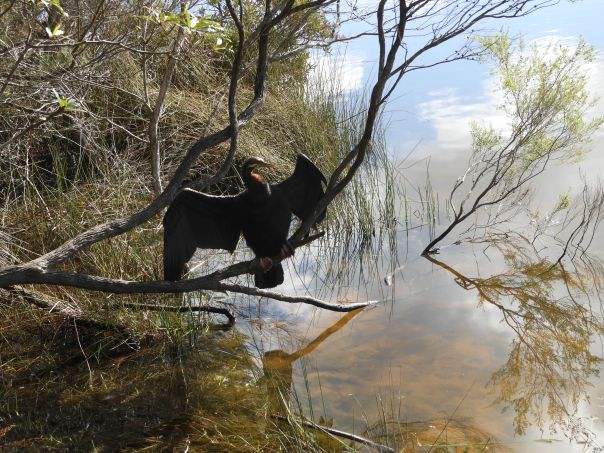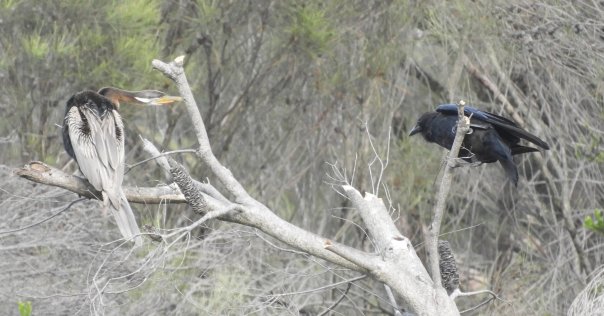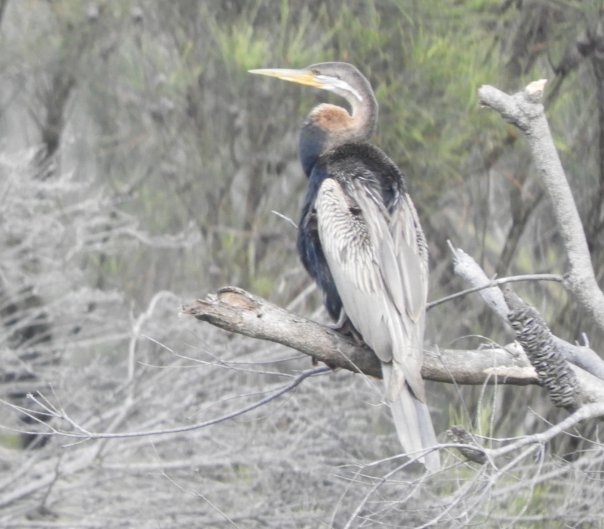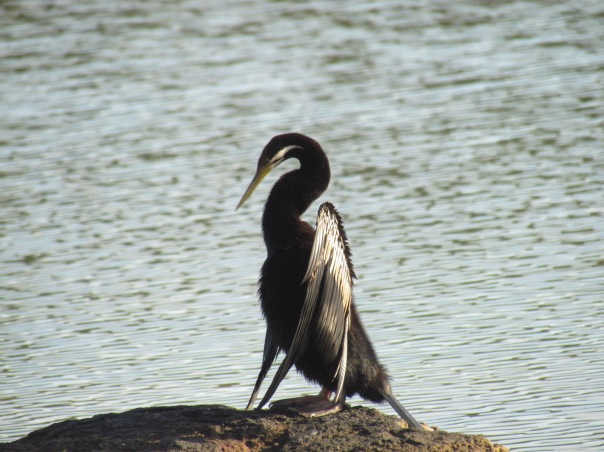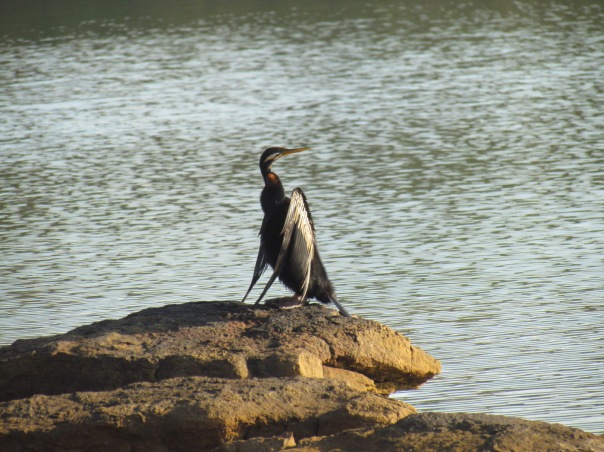Category Archives: Darter
What does a Darter sound like? Plus random turtles.
Darters are large water birds, a bit like cormorants. They make a weird cackling sound, a bit like a sardonic duck. And they only do it every now and then, for a short time, so you have to just be there with your camera ready if you want to record the call.
I was lucky to be looking at a kingfisher through the camera lens when a darter started cackling nearby. Here’s what I got on camera — the darter call is right at the start of the video. Also, when watching the video I noticed there are a couple of turtles on a log at bottom left of the shot, visible just as the camera starts zooming out.
Here’s the darter with its beak open. I’m not sure if it was thinking of cackling again or if something was tickling its throat. It is, after all, rather a long throat:
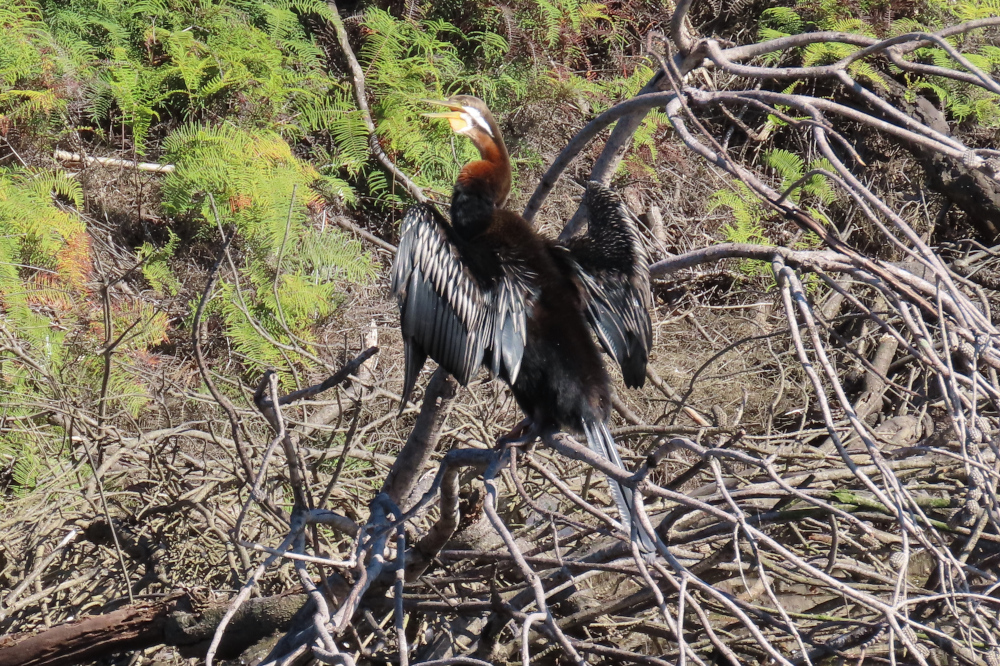
Here’s a pic showing the turtles on the log at bottom left. I didn’t know they were there until I saw the photos on a big screen. There are at least two turtles, one behind the other, and possibly a third below them:

This bird is a male, with its black neck and red throat.
Common name: Darter
Scientific name: Anhinga melanogaster
Approximate length: 90 cm; wing span: 1.2 m
Date spotted: 10 October 2024 (spring)
Location: Manly Dam Reserve, New South Wales, Australia: 33°46’34.7″S 151°14’48.9″E
Birds galore at Long Reef Aquatic Reserve, Collaroy
Last week I spent a couple of hours at Long Reef Aquatic Reserve in Collaroy, NSW. I was there just for a walk with my partner, but I was delighted at the number and variety of birds we encountered.
First up were two raptors, a real treat to see. A Black-shouldered Kite (Elanus axillarus) hovered in the air, effortlessly riding the currents and looking out for prey:
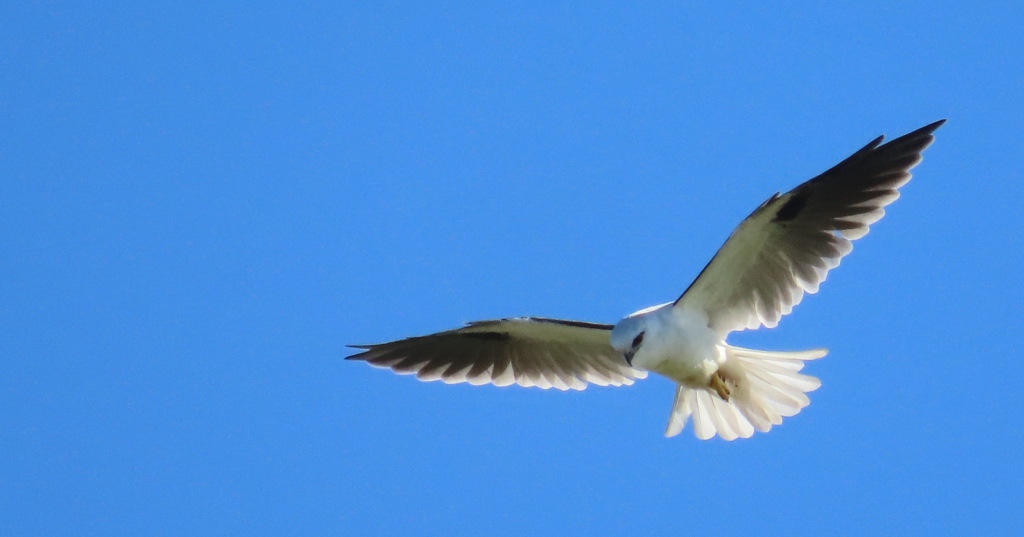
An Eastern Osprey (Pandion cristatus) soared in circles, grasping a half-eaten fish in its feet:
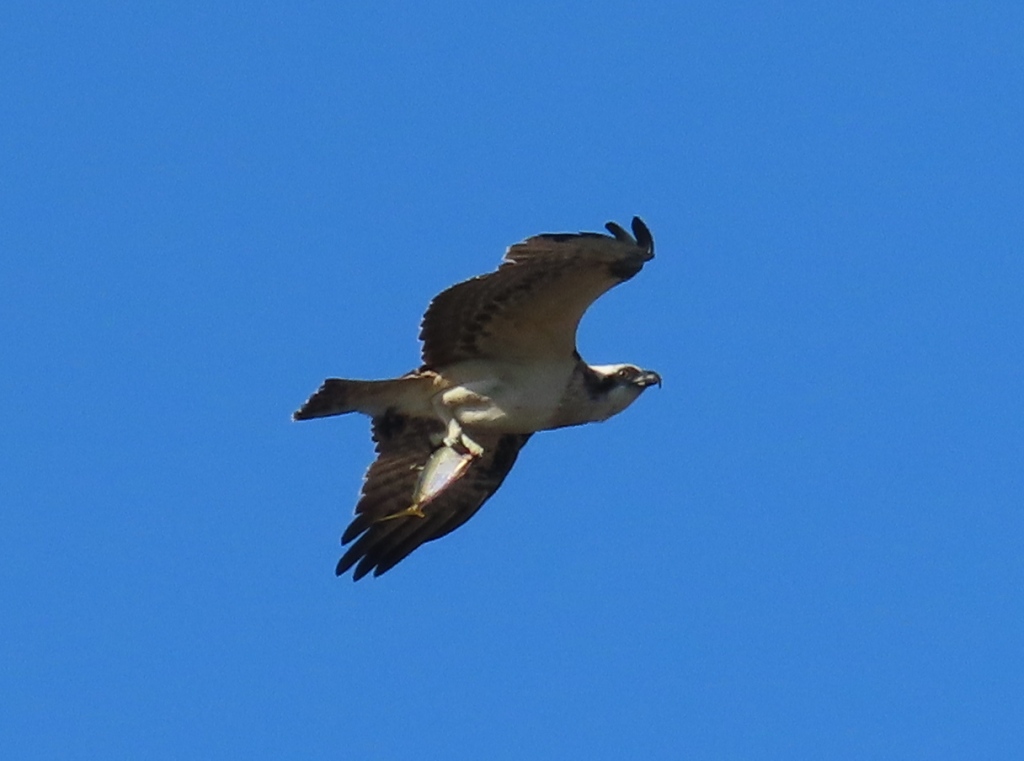
I’ve written a separate post about these two birds, a third raptor, and some paragliders who shared the air currents with the kite: Three raptors in one day.
Huge Pelicans (Pelecanus conspicillatus) perched on the lampposts and glided above my head. Here’s one of them, looking sad and wise:
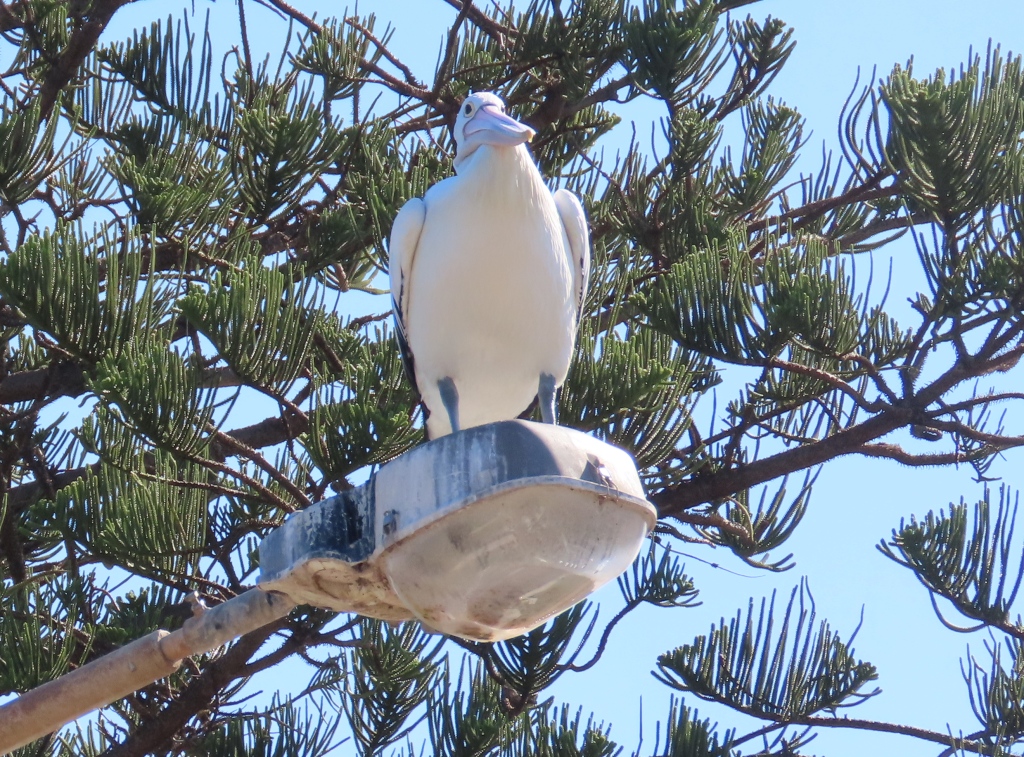
Another post has more pictures of these magnificent birds: Three pelicans on a lamppost.
A female Darter (Anhinga melanogaster) sat on a metal structure above the beach, surveying all the action with a cautious eye:

Silver Gulls (Larus novaehollandiae) wheeled around the fishermen at the edge of the rock plate:

Australian Ravens (Corvus coronoides) picked through the stranded seaweed in search of a snack:

Here’s a close-up of one of the ravens:
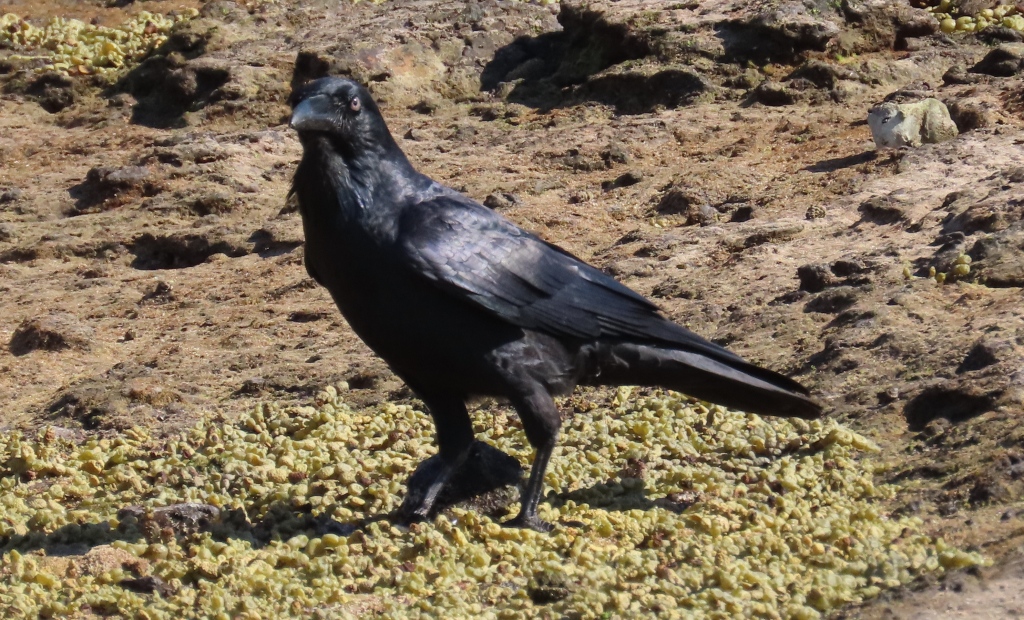
Fish skulked in a nearby rock pool:

A crab came out from under a rock, ready to dash back in at the slightest sign of danger:

A White-faced Heron (Ardea novaehollandiae) patrolled the border between land and sea:
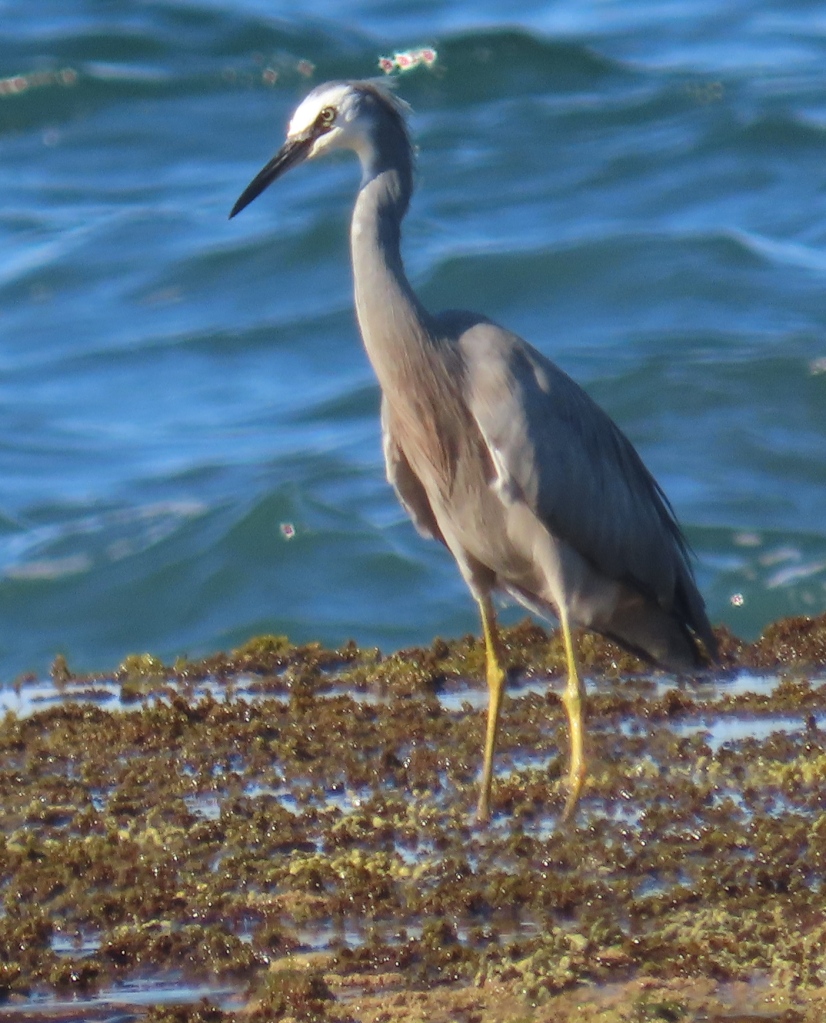
On the grassy headland above the beach, a Magpie-lark (Grallina cyanoleuca) owned the land. These birds are also called Peewees, because of the loud shrill call (peeee-wheee) that they make whenever a person or anything else comes too close:
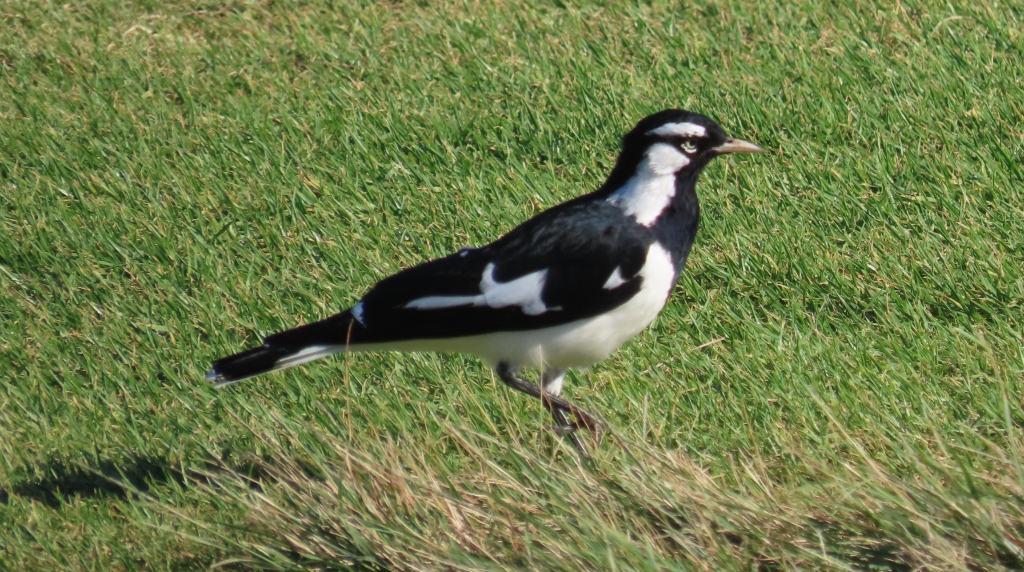
To close off with, here are a couple of shots showing the colours and serenity of the Long Reef Aquatic Reserve that afternoon. First, looking from the rock plate towards the land:
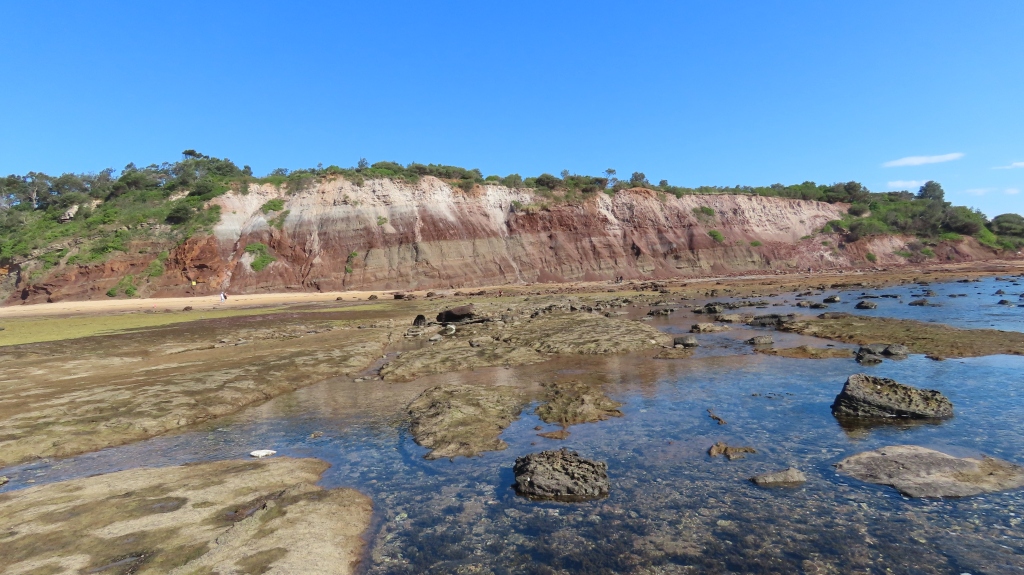
Then looking out to sea:

Two Darters for the price of one
Yesterday and again today I saw a Darter in an inlet of Manly Dam. I think they’re two different birds, because yesterday’s bird looks darker in colour. That could be because it’s more mature than the one in the same spot today, or it might be that yesterday’s bird was male while today’s was female.
Today’s Darter was perched in full sunlight on a dead tree. At the start of the video, the bird has stretched its wings out to dry, in the pose that’s characteristic of Darters and Cormorants. The bird is doing a bit of preening. The camera zooms out to show the surrounds: an inlet of Manly Dam near Sydney, Australia. Then a couple of joggers approach. The camera zooms back in to see the Darter’s slight unease at the sound of approaching people. The bird turns and stretches its long neck to check for danger. The joggers pass by underneath the bird, and all goes back to normal after a bit of a shuffle to get the feathers back in order:
Darters are often called snakebirds, due to their long, snake-like necks. It’s good to see the neck in action! They eat fish, which they catch by spearing them with that long sharp beak.
Here’s a still photo of the bird, showing a leery eye:
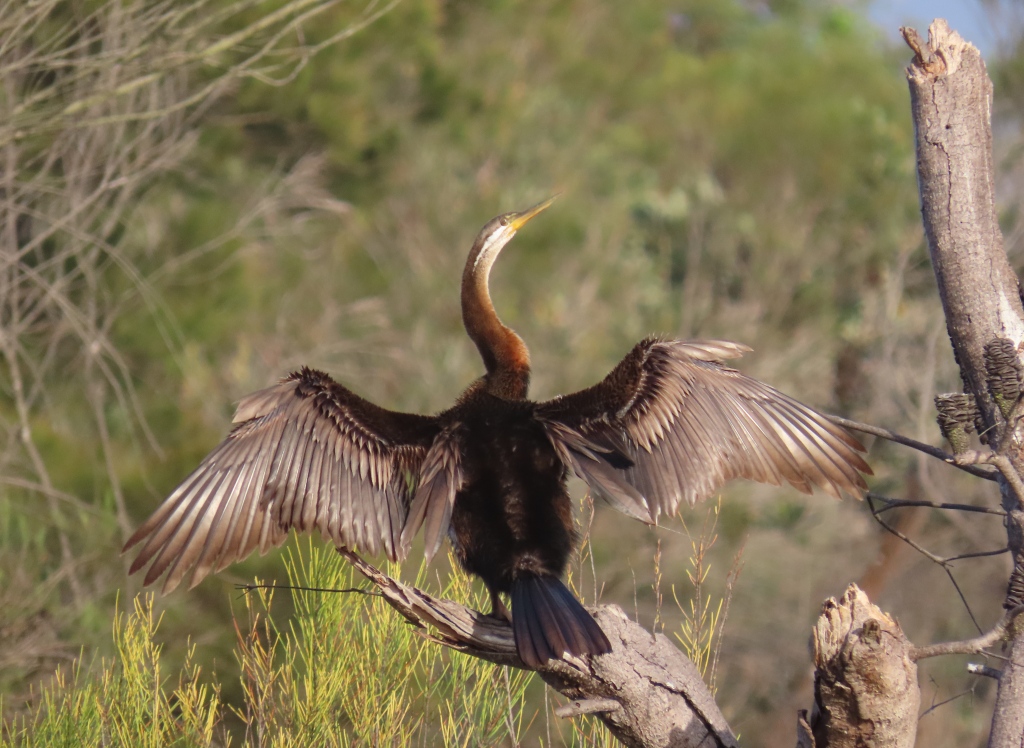
Yesterday’s bird was lower down, closer to the water and in shade. Its head, neck, and body look much darker in colour, and its wings more silvery:
Back in June this year, a cream-coloured Darter roosted in the same spot. The colouring of that bird surprised me, as I’d only seen dark brown or black ones up to that point.
Common name: Darter
Scientific name: Anhinga melanogaster
Approximate length: 90 cm; wing span: 1.2 m
Date spotted: 25 and 26 December 2023 (summer)
Location: Manly Dam Reserve, New South Wales, Australia: 33°46’34.7″S 151°14’48.9″E
Darter with cream-coloured neck
This lovely light-coloured Darter took me by surprise!
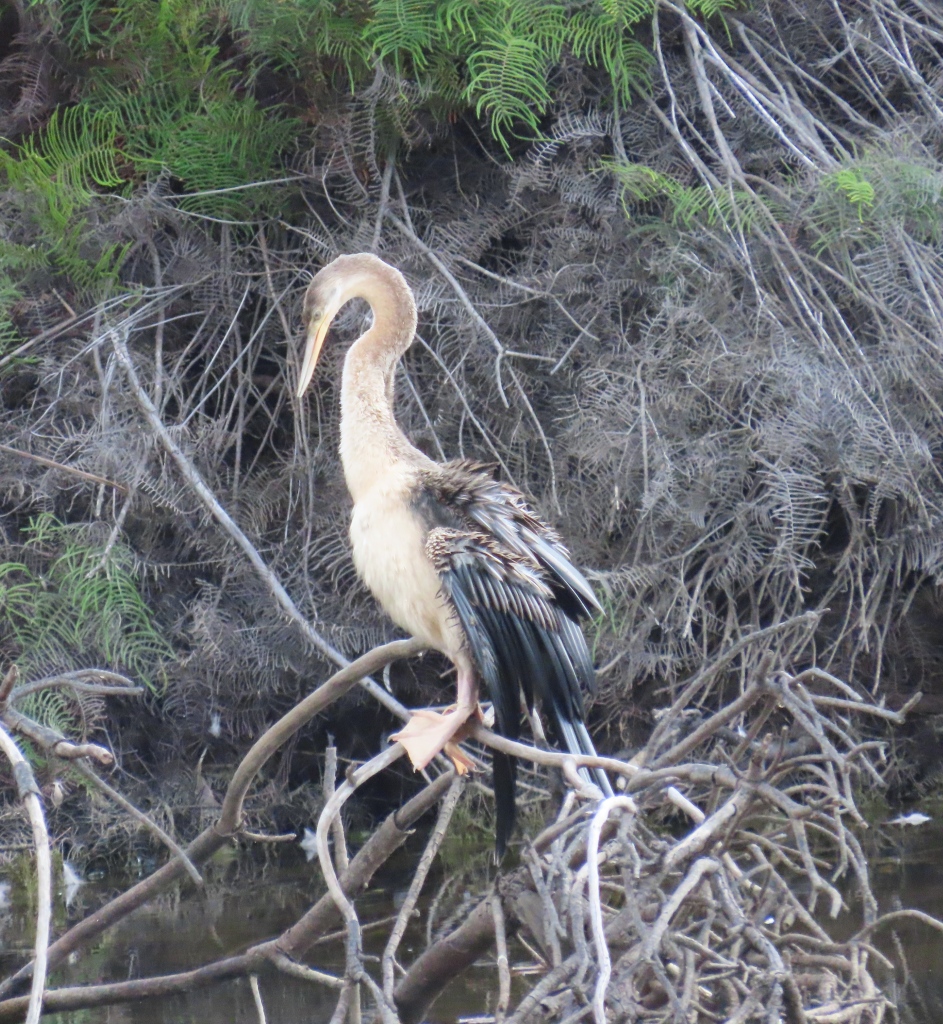
The only Darters I’ve seen up to now have been very dark in colour, with black necks and bodies. You can see them in my posts about the sinuous neck of a Darter and a Darter drying its wings then taking off.
Evidently it’s the males that are dark in colour, whereas the females and juveniles are lighter. Judging by the overall state of dishevelment of this bird’s feathers, I’d say it’s a juvenile.
This video shows the impressive length of the bird’s neck when the bird lifts its head to listen to an unusual sound:
The next video shows another neck stretch, with the bird looking in the direction of the camera:
Common name: Darter
Scientific name: Anhinga melanogaster
Approximate length: 90 cm; wing span: 1.2 m
Date spotted: 2 June 2023 (winter)
Location: Manly Dam Reserve, New South Wales, Australia: 33°46’34.7″S 151°14’48.9″E
Birds from a boat on the Daintree River
In May this year I was lucky enough to visit Far North Queensland. While there, I took an early morning boat trip on the Daintree River (map). The tour, run by Ian “Sauce” Worcester, was called the Daintree River Wild Watch. Highly recommended!
The river is gorgeous in the early morning chill:
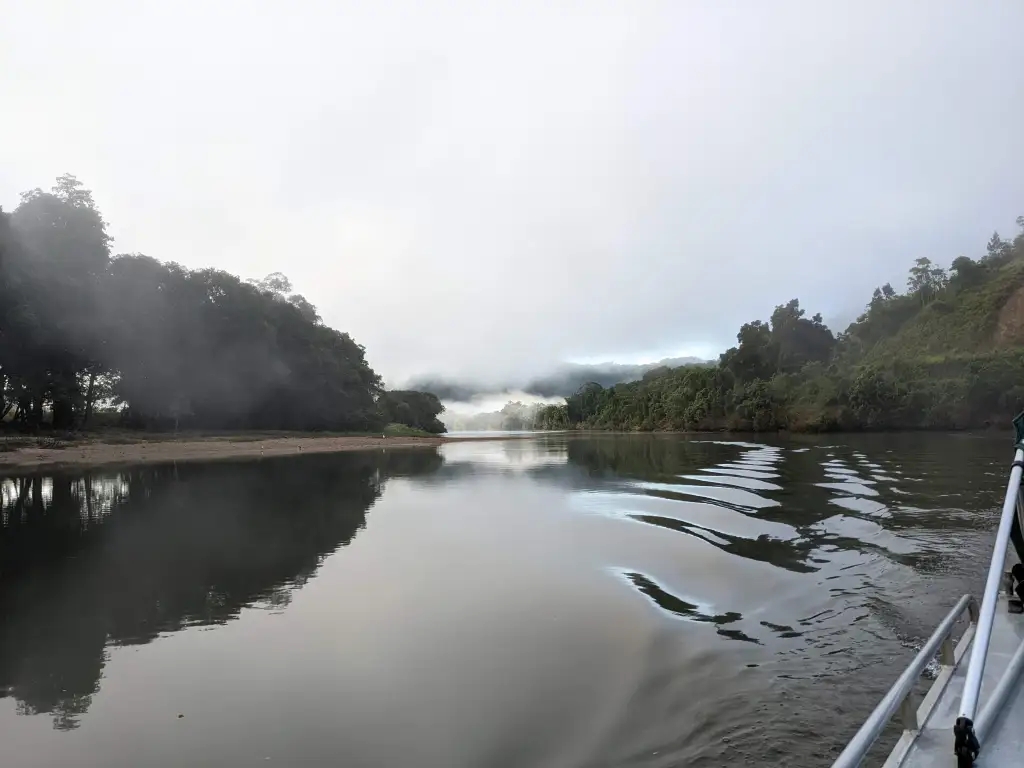
We saw a number of kingfishers on the banks of the river. This one is a Sacred Kingfisher:
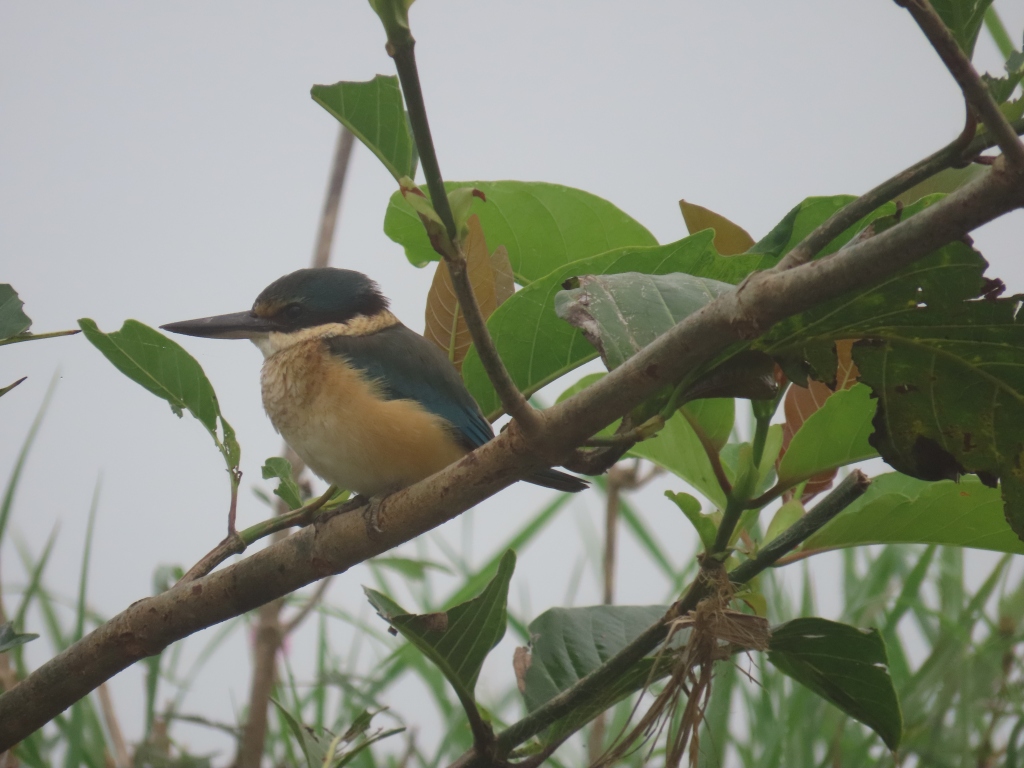
Another Sacred Kingfisher:

A Spectacled Monarch hid in the undergrowth of the mangrove forest. Our boat followed it quietly until it came into easy view:
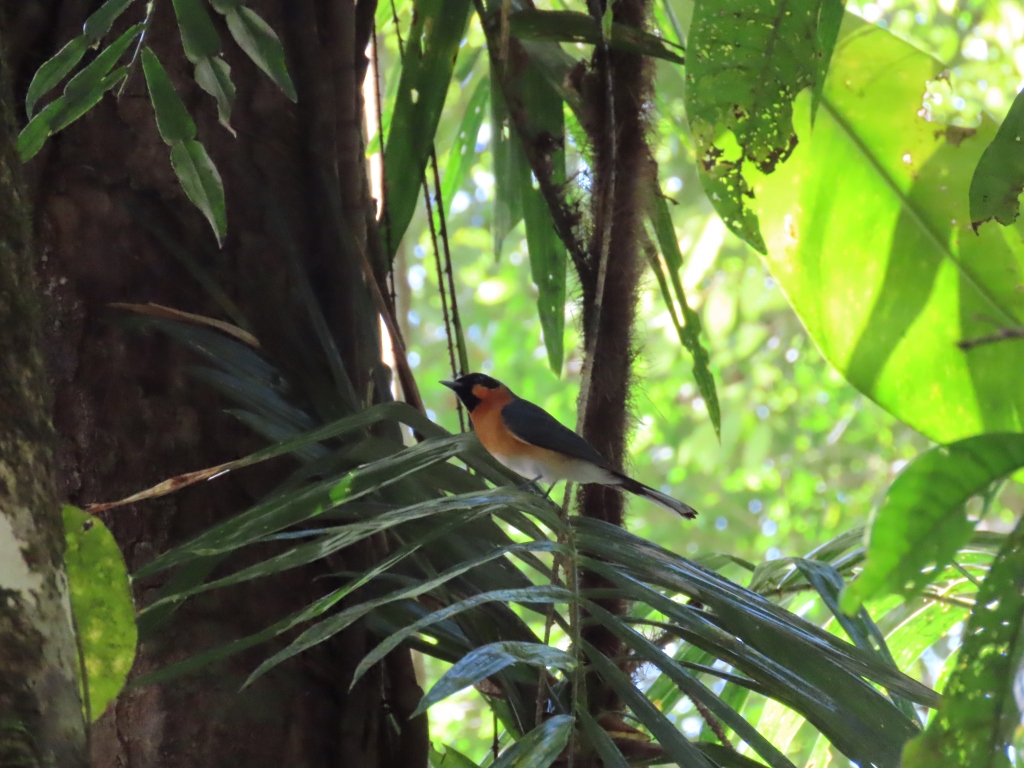
As the sun came up, a Rainbow Bee-eater landed on a high-up tree branch and fluffed out its feathers to take advantage of the warmth:
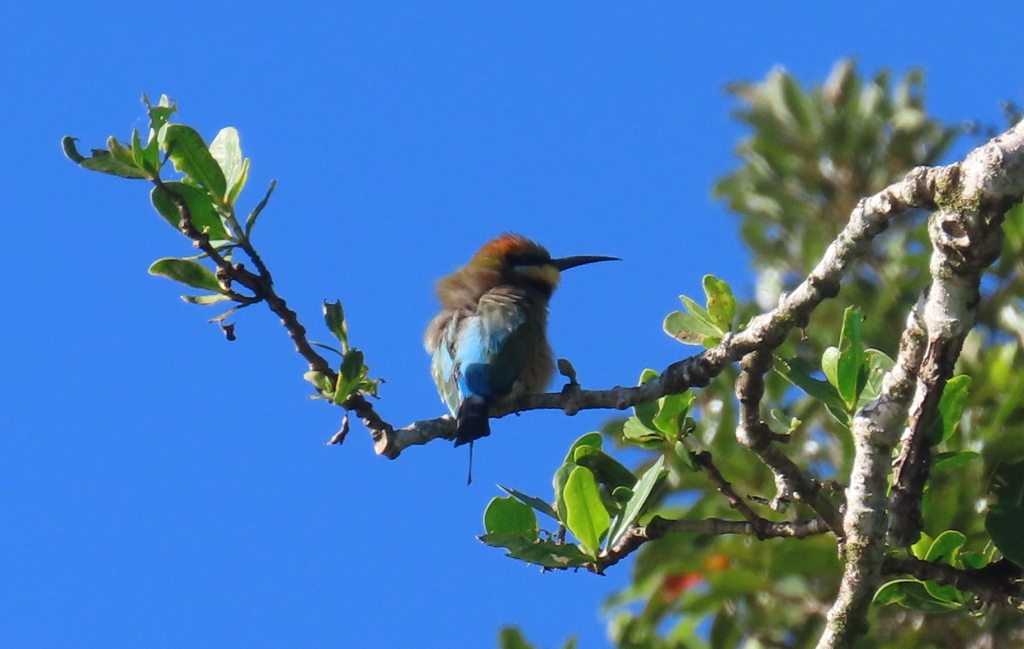
Here’s another view of the Rainbow Bee-eater:
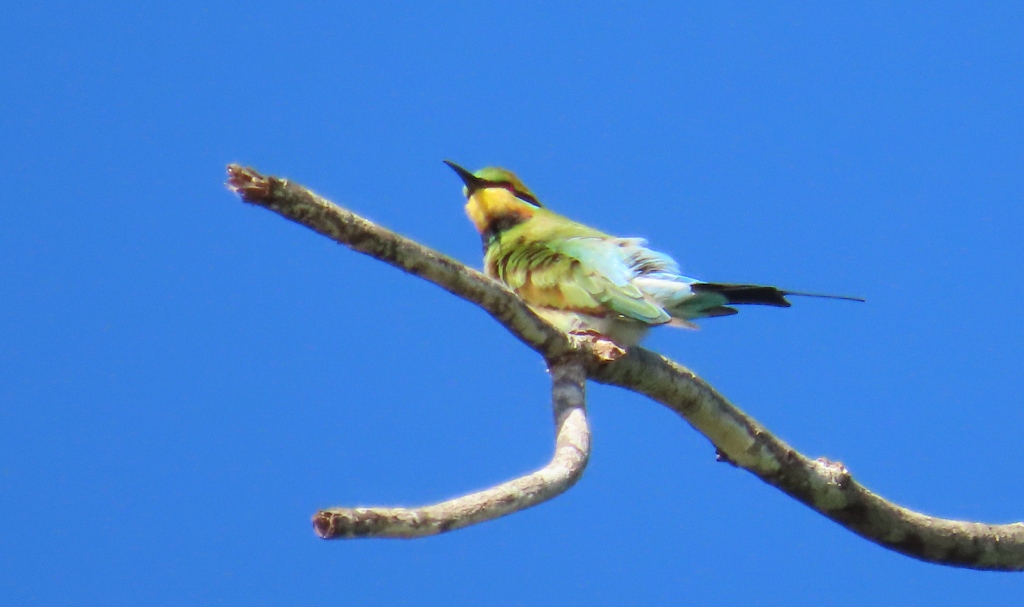
The river banks were at times covered in mangrove forests or fig trees. High above our heads, flowers bloomed:
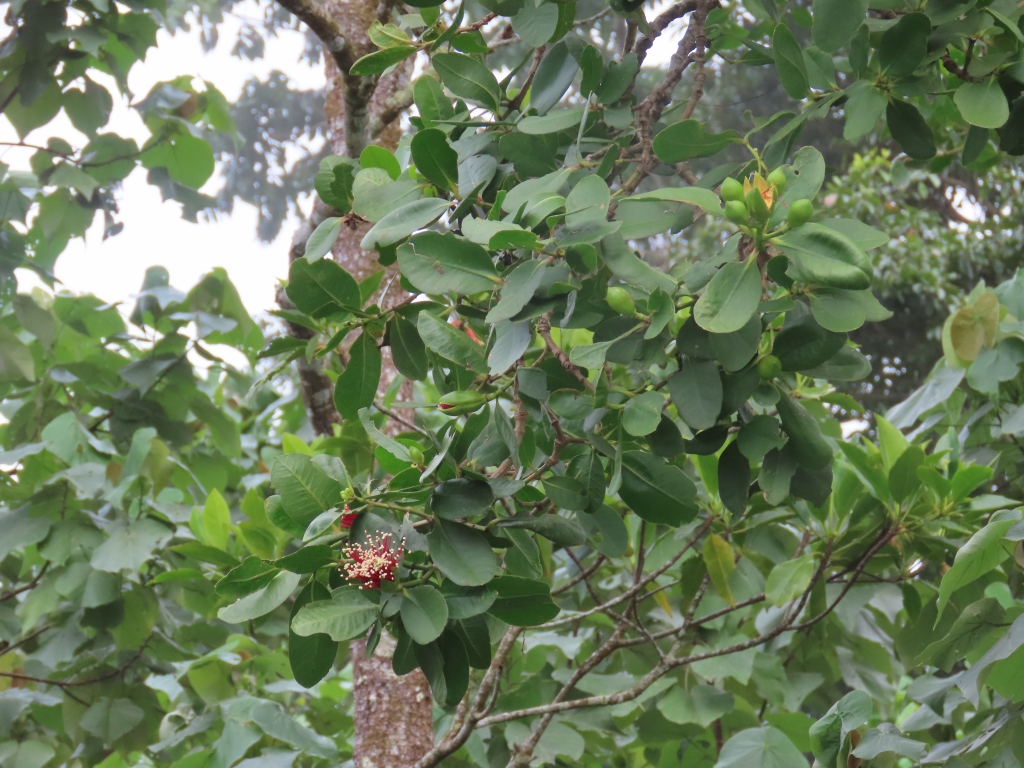
Waterbirds included these colourful Radjah Shelducks, sometimes called Burdekin ducks:

Another non-descript-looking duck caused some excitement, as our tour guide thought it might be a whistling duck but I can’t identify it. If anyone can say what it is, let me know:
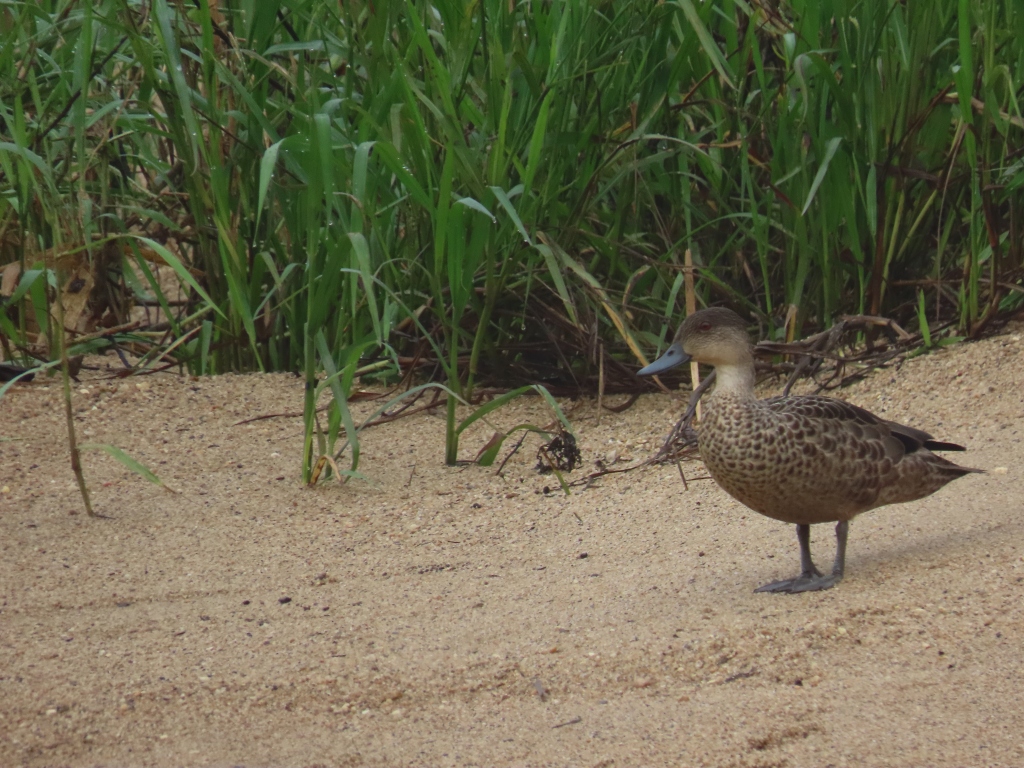
We saw a Darter roosting close to a Little Pied Cormorant. In this photo, the cormorant is behind the darter looking towards the right. The darter is in front, with its back to us, looking towards the left:
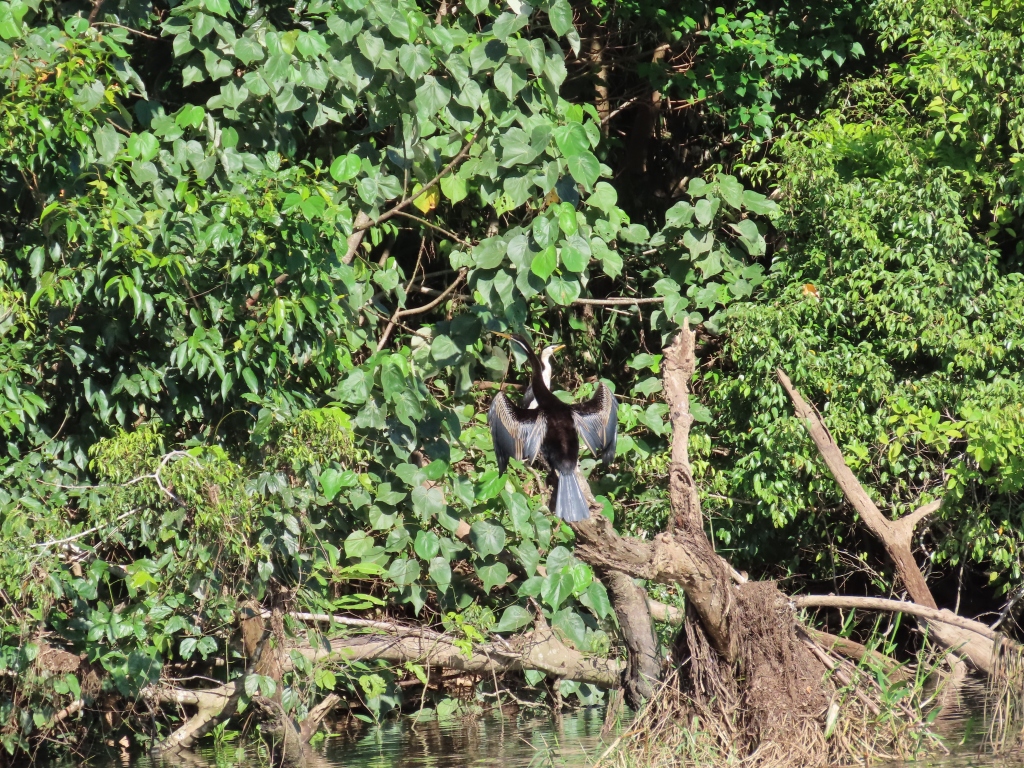
Three Little Pied Cormorants kept us company on the water. You can see the dense forest that covered much of the river bank:

An egret kept pace for a while too:
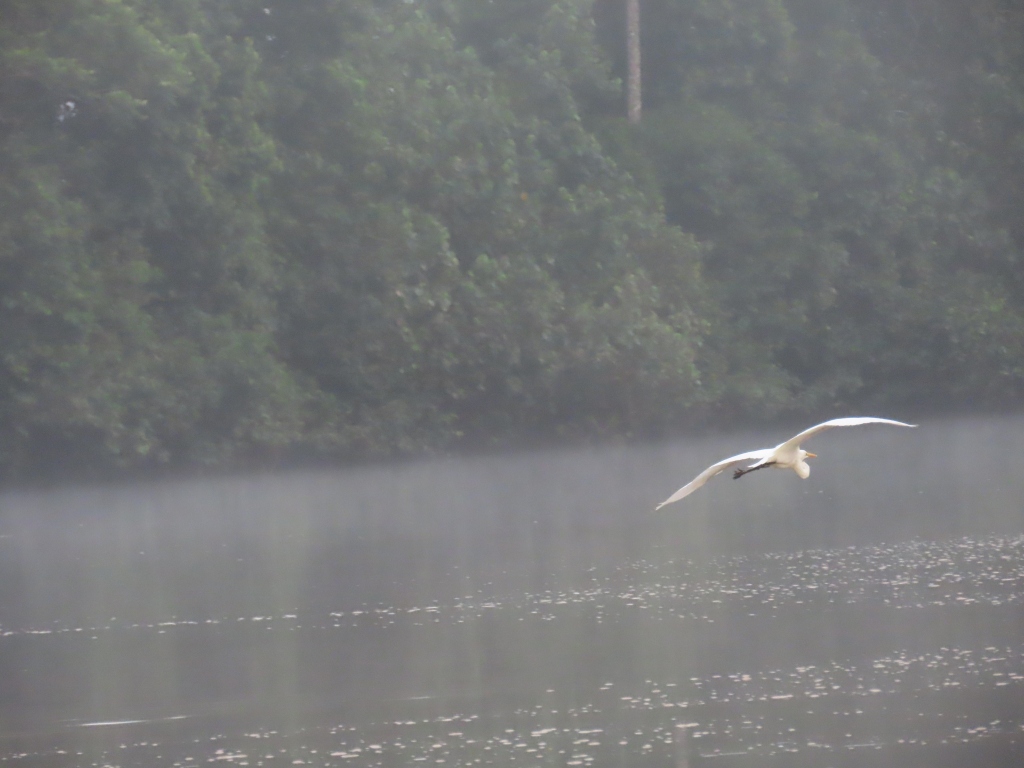
The sinuous neck of a Darter
Darters are sometimes called snakebirds, because of their long, sinuous necks. I came across this small darter sheltering on a branch close to the footpath at Manly Dam.
The bird didn’t seem to be worried by my presence. I stood and watched it for a while, enjoying the supply movements of its wings and neck:
At one stage a couple of ravens started cawing. The darter showed some concern, looking skywards to see if there was any threat:
Darters use that long neck to hunt underwater, straightening it suddenly to dash out and catch their prey.
Here’s a close-up shot of the bird’s head, neck, and shoulders, with the neck coiled up in the resting pose:
The bird’s feet are webbed, good for swimming and for clasping a branch:
Spreading its feathers prior to a stretch:
Like cormorants, darters need to hold out their wings to dry:
Common name: Darter
Scientific name: Anhinga melanogaster
Approximate length: 90 cm; wing span: 1.2 m
Date spotted: 30 June 2020 (winter)
Location: Manly Dam Reserve, New South Wales, Australia: 33°46’38.5″S 151°14’57.0″E
Darter fends off Australian Ravens
Darters are large, decorative birds with long, snake-like necks and intricate feather patterns on their backs. This Darter drew the attention of some Australian Ravens. I watched for a few minutes as the ravens dropped in to harass the larger bird. The Darter came out on top every time:
Here are some still pictures of the Darter, to give you a better idea of what it looks like. First, in an argument with a raven:
The next one gives a good view of the Darter’s long neck:
The Darter in a more contemplative pose:
I think the patterns of the feathers on the bird’s back are lovely:
The last time I saw one of these birds was a couple of years ago, when it was hanging out its wings to dry in a pose that reminded me of a ballerina.
Common name: Darter
Scientific name: Anhinga melanogaster
Approximate length: 90 cm; wing span: 1.2 m
Date spotted: 15 December 2019 (summer)
Location: Manly Dam Reserve, New South Wales, Australia: 33°46’34.3″S 151°14’48.6″E
Darter drying wings then taking off
At first sight I thought this bird was a cormorant, but it’s actually a darter, also known as a snake bird because of its long, snake-like neck. Darters are related to cormorants, and also to boobies and gannets. They swim fast under water, hunting and impaling fish with their formidable long, thin beak.
Like cormorants, they sit on shore with their wings spread to dry. After I’d been watching this one for a few minutes, it decided to take off and fly over the water. It’s interesting to see how low it flies, with the wing tips actually tapping the water as it goes.
This pose reminded me of the ballet, the Dying Swan:
Here you can see the characteristic chestnut colouring at the base of the darter’s neck:
Common name: Darter
Scientific name: Anhinga melanogaster
Approximate length: 90 cm; wing span: 1.2 m
Date spotted: 12 February 2017 (Summer)
Location: Manly Dam Reserve, New South Wales, Australia: 33°46’49.6″S 151°15’05.7″E






